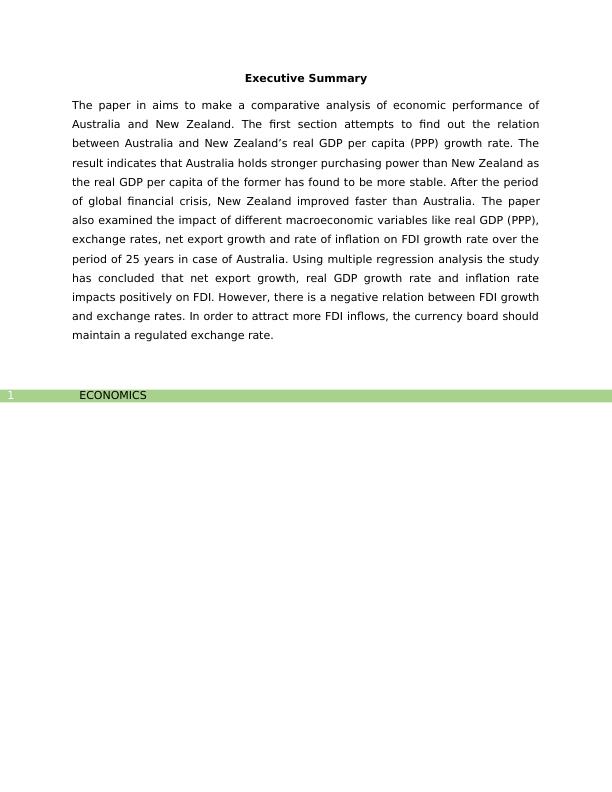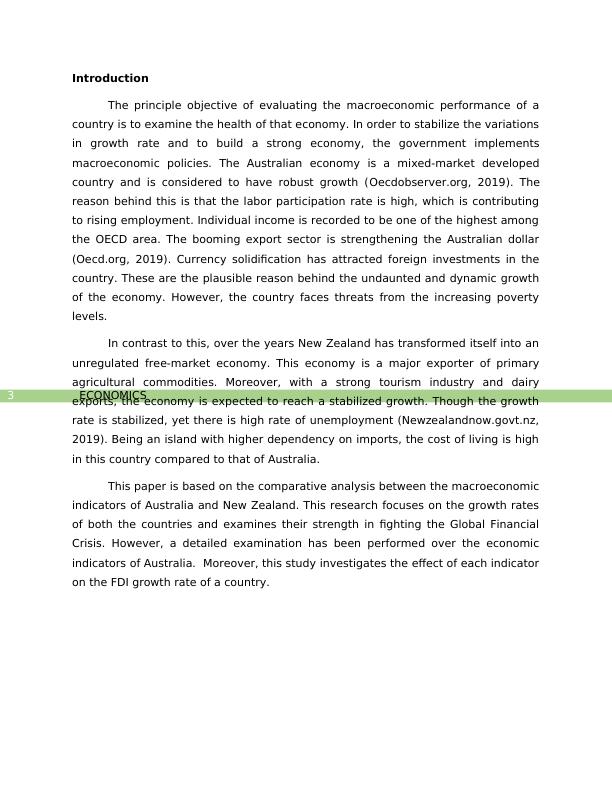Comparative Analysis of Economic Performance of Australia and New Zealand
Added on 2022-12-30
17 Pages3943 Words59 Views
Running head: ECONOMICS
Economics
Name of the Student
Name of the University
Course ID
Economics
Name of the Student
Name of the University
Course ID

ECONOMICS1
Executive Summary
The paper in aims to make a comparative analysis of economic performance of
Australia and New Zealand. The first section attempts to find out the relation
between Australia and New Zealand’s real GDP per capita (PPP) growth rate. The
result indicates that Australia holds stronger purchasing power than New Zealand as
the real GDP per capita of the former has found to be more stable. After the period
of global financial crisis, New Zealand improved faster than Australia. The paper
also examined the impact of different macroeconomic variables like real GDP (PPP),
exchange rates, net export growth and rate of inflation on FDI growth rate over the
period of 25 years in case of Australia. Using multiple regression analysis the study
has concluded that net export growth, real GDP growth rate and inflation rate
impacts positively on FDI. However, there is a negative relation between FDI growth
and exchange rates. In order to attract more FDI inflows, the currency board should
maintain a regulated exchange rate.
Executive Summary
The paper in aims to make a comparative analysis of economic performance of
Australia and New Zealand. The first section attempts to find out the relation
between Australia and New Zealand’s real GDP per capita (PPP) growth rate. The
result indicates that Australia holds stronger purchasing power than New Zealand as
the real GDP per capita of the former has found to be more stable. After the period
of global financial crisis, New Zealand improved faster than Australia. The paper
also examined the impact of different macroeconomic variables like real GDP (PPP),
exchange rates, net export growth and rate of inflation on FDI growth rate over the
period of 25 years in case of Australia. Using multiple regression analysis the study
has concluded that net export growth, real GDP growth rate and inflation rate
impacts positively on FDI. However, there is a negative relation between FDI growth
and exchange rates. In order to attract more FDI inflows, the currency board should
maintain a regulated exchange rate.

ECONOMICS2
Table of Contents
Introduction................................................................................................................ 3
Relation between Australia and New Zealand’s real GDP per capita..........................4
Relation between growth of FDI and other macroeconomic variables........................5
FDI growth and Real GDP (PPP) growth...................................................................5
FDI growth and net export growth..........................................................................7
FDI growth and exchange rate growth....................................................................8
FDI growth and inflation rate................................................................................. 10
Regression of FDI growth on other macro variables.................................................11
Policy Implication...................................................................................................... 12
Conclusion................................................................................................................ 13
References............................................................................................................... 14
Table of Contents
Introduction................................................................................................................ 3
Relation between Australia and New Zealand’s real GDP per capita..........................4
Relation between growth of FDI and other macroeconomic variables........................5
FDI growth and Real GDP (PPP) growth...................................................................5
FDI growth and net export growth..........................................................................7
FDI growth and exchange rate growth....................................................................8
FDI growth and inflation rate................................................................................. 10
Regression of FDI growth on other macro variables.................................................11
Policy Implication...................................................................................................... 12
Conclusion................................................................................................................ 13
References............................................................................................................... 14

ECONOMICS3
Introduction
The principle objective of evaluating the macroeconomic performance of a
country is to examine the health of that economy. In order to stabilize the variations
in growth rate and to build a strong economy, the government implements
macroeconomic policies. The Australian economy is a mixed-market developed
country and is considered to have robust growth (Oecdobserver.org, 2019). The
reason behind this is that the labor participation rate is high, which is contributing
to rising employment. Individual income is recorded to be one of the highest among
the OECD area. The booming export sector is strengthening the Australian dollar
(Oecd.org, 2019). Currency solidification has attracted foreign investments in the
country. These are the plausible reason behind the undaunted and dynamic growth
of the economy. However, the country faces threats from the increasing poverty
levels.
In contrast to this, over the years New Zealand has transformed itself into an
unregulated free-market economy. This economy is a major exporter of primary
agricultural commodities. Moreover, with a strong tourism industry and dairy
exports, the economy is expected to reach a stabilized growth. Though the growth
rate is stabilized, yet there is high rate of unemployment (Newzealandnow.govt.nz,
2019). Being an island with higher dependency on imports, the cost of living is high
in this country compared to that of Australia.
This paper is based on the comparative analysis between the macroeconomic
indicators of Australia and New Zealand. This research focuses on the growth rates
of both the countries and examines their strength in fighting the Global Financial
Crisis. However, a detailed examination has been performed over the economic
indicators of Australia. Moreover, this study investigates the effect of each indicator
on the FDI growth rate of a country.
Introduction
The principle objective of evaluating the macroeconomic performance of a
country is to examine the health of that economy. In order to stabilize the variations
in growth rate and to build a strong economy, the government implements
macroeconomic policies. The Australian economy is a mixed-market developed
country and is considered to have robust growth (Oecdobserver.org, 2019). The
reason behind this is that the labor participation rate is high, which is contributing
to rising employment. Individual income is recorded to be one of the highest among
the OECD area. The booming export sector is strengthening the Australian dollar
(Oecd.org, 2019). Currency solidification has attracted foreign investments in the
country. These are the plausible reason behind the undaunted and dynamic growth
of the economy. However, the country faces threats from the increasing poverty
levels.
In contrast to this, over the years New Zealand has transformed itself into an
unregulated free-market economy. This economy is a major exporter of primary
agricultural commodities. Moreover, with a strong tourism industry and dairy
exports, the economy is expected to reach a stabilized growth. Though the growth
rate is stabilized, yet there is high rate of unemployment (Newzealandnow.govt.nz,
2019). Being an island with higher dependency on imports, the cost of living is high
in this country compared to that of Australia.
This paper is based on the comparative analysis between the macroeconomic
indicators of Australia and New Zealand. This research focuses on the growth rates
of both the countries and examines their strength in fighting the Global Financial
Crisis. However, a detailed examination has been performed over the economic
indicators of Australia. Moreover, this study investigates the effect of each indicator
on the FDI growth rate of a country.

End of preview
Want to access all the pages? Upload your documents or become a member.
Related Documents
Comparative Analysis of Macroeconomic Performance of Australia and New Zealandlg...
|20
|3563
|292
Evaluation of the Macroeconomic Performance of Australia and USAlg...
|13
|3576
|482
Sample Assignment on Economics USAlg...
|12
|3886
|36
Macroeconomics Performance of Australialg...
|14
|4190
|34
Macroeconomics Indicators Australialg...
|17
|3641
|103
Analysis of Macroeconomic Factors of China's Economic Performancelg...
|12
|3112
|76
